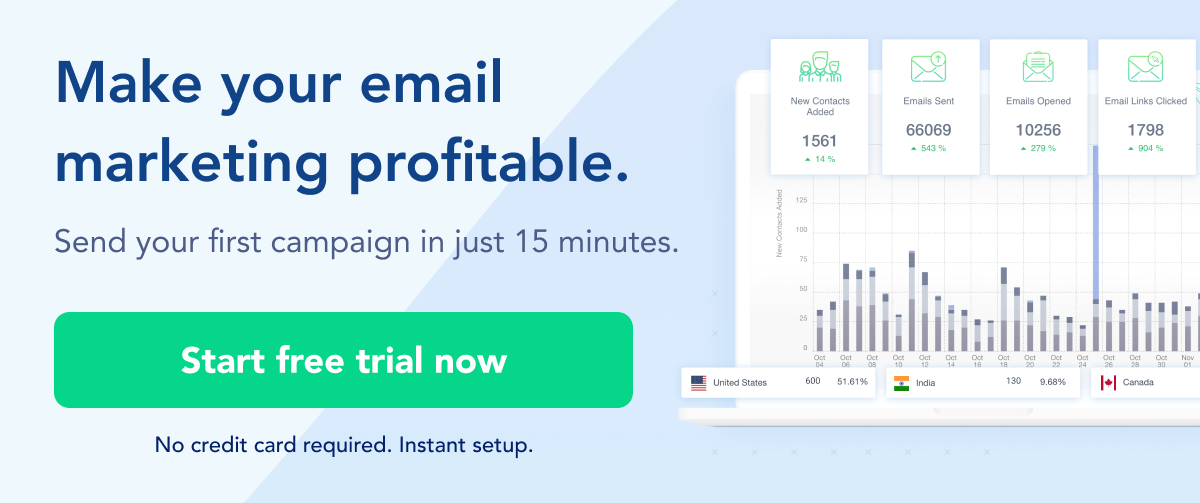Marketers know email marketing is far from dead. Infact, it continues to be one of the essential communication channels for brands. The power of emails is undeniable, but what follows is the sheer competition to stand out.
Effective email marketing campaigns go through four major stages:
- Brainstorming and planning stage
- Designing and creating the email layout, content, CTA, etc.
- Scheduling and launching the campaign
- Monitoring and analyzing the key metrics
While this is what an email campaign roadmap looks like, what is often not discussed is including email campaign management practices in the marketing strategy. The campaign management practices run parallel with the creating and launching of an email campaign.
What is email marketing campaign management?
Email campaign management, by definition, addresses the interconnected process of ideating, creating, launching, and monitoring an email campaign. Multiple steps encompass this process, and email campaign management practices help streamline it.
Challenges of email campaign management
You cannot do without having email campaign management practices in place, but you cannot do it without addressing the two core challenges -
Streamlining the entire process end-to-end
An email marketing campaign is not one-task bound. There are multiple parts to it. One common challenge most marketers face is getting every part of the campaign up and running on time. The design, content, layout, testing, scheduling, and monitoring must be streamlined.
If there is a delay in any of the steps, the email campaign stops. In campaign management, one main challenge is having everything ticked and done on time.
Handling email marketing assets
Assets are the building blocks of your email. Sometimes, you must go beyond the marketing team to get your email campaign's required assets or information. The whole coordination between different teams can either be super quick or falter while waiting on one another.
This is in sync with streamlining but is still a recurring challenge in email campaign management.
Email Campaign Management Practices to Start Implementing
Effective campaign management includes the following stages:
- Create clean email lists with proper segmentation and tags
- Design and edit email templates
- Set up automated drip sequences using a business email address to avoid spam filters
- Personalize the email content using dynamic and interactive content
- A/B test emails and optimize to get desired results
- Schedule campaign at specific timings for better engagement, especially if targeting a global audience
- Track, report, and analyze key engagement and conversion metrics
- Implement integrations with your CRM or any essential platform to streamline management.
Whether sending a one-off email or an automated drip, these email campaign management practices are essential to tie all your efforts into one place and monitor the overall email performance.
1. Define clear campaign objectives
Having a clear objective can help manage the implementation and monitoring of your email campaign.
Before you start designing your campaign, ask questions like:
- What do I want to achieve with this campaign?
- What metrics do I want to measure?
Once you know what results you want to drive through your email campaigns, you can align them with your marketing, sales, and overall business goals.
Defining your goals helps in:
- Creating email content that aligns with your goals
- Defining the drip sequence to propel lead engagement in the right direction
- Making quick decisions throughout the process
- Optimizing the campaign through A/B testing
- Target the right kind of audience at the right time.
Here’s an example of how a clearly defined goal is pivotal in the campaign management process.
Goal: Your email campaign goal — to update your Pro plan subscribers about a new feature addition that was initially part of the higher-paid plans. The subscribers to the Pro plan get to access this feature for free, while free users can take a trial of 7 days.
Campaign management process: Now that you have a clearly defined goal, your next steps include the following:
- Segmenting your subscribers that fit the bill
- Creating dynamic content to show relevant messages to every subscriber across all stages
- Plan out the drip sequence based on user engagements
- Make sure the CTA, UI, language, etc. match with your brand voice
- Test your campaigns until you see the desired engagement metrics
- Schedule based on your subscribers’ demographics and engagements
- Monitor and optimize your drip sequence to drive better results
A clearly defined goal helps streamline and manage the whole process, from start to finish.
2. Implement email marketing tools
Email marketing tools are designed to make email campaigns smooth. Email marketing tools have everything from ready-to-use email templates to sorting out server issues.
Using an email marketing tool can help in effective email campaign management as it centralizes the entire process into one place. Thus, managing and monitoring is easier with all dashboards and reports in one place. Add to this, you can have your teams work together on your email campaigns cohesively.
However, multiple tools are available, and choosing one may seem daunting. The easiest way to decide is to opt for a tool that serves your end goals and fits your business requirements. Generally speaking, here are a few things that your email marketing tool must have:
- Security: Email communications are more than just sending brand information or updates. Email addresses are personal and are sensitive customer data. Choose an email marketing tool with the best data protection practices, like the DMARC email authentication standards.
- Segmentation: This is a no-brainer. Your email marketing tool must have this feature along with user tagging. Many tools offer features like adding notes for internal teams against user profiles for better email engagements.
- Easy to use: You need a tool that will save time. If your tool is complicated to use, then you must reconsider. It should be a smooth ride from ready-to-use templates to creating dynamic content and adding media.
- Email automation: Again, this is a no-brainer and an essential one. Choose a tool that has automated workflows ready to implement, triggered sends, A/B testing, and global email scheduling options.
- Third-party integrations: Ensure your email marketing tool integrates with your CRM and task management tools. Otherwise, the whole process will have multiple breaks while you juggle between multiple tools.
3. Develop a comprehensive content calendar
Using a content calendar for your email campaigns is a good starting point for organizing and managing the campaigns. In email marketing, delivering the right message at the right time and to the right audience is essential. You can do all these in one go with a planned content calendar ready to track.
To manage and be on track, start by elaborately mapping out your email campaigns. Plan what messaging you want to deliver, how you want to create it, and the to-do's to get things rolling on D-day.
Your content calendar will help you map your campaign ideas, timeline, design ideas, message tone, CTA, landing pages, meme ideas, metrics to monitor, team members leading each part of the campaign, and more.
You can build a calendar manually using Google Sheets or opt for any of the ready-to-use email content calendar tools. A content calendar for email campaign management helps in:
- Map campaign goals
- Map event-specific or occasion-specific one-off campaigns
- Assign team members for each task
- Plan the drip sequences
- Map target audience
- Decide when a campaign starts and when it goes on or after how many minutes, hours, or days the drip sequences initiate
- Measure the important KPIs and take a collective look at the performance metrics
4. Segment and personalize your email campaigns
The impact and need for segmentation and personalized messaging have been in talks since the start of this article.
These two act like the backbones of any email campaign. When you want to implement the best practices to manage your email campaigns, focusing on accurate segmentation and delivering personalized messages can do wonders for you.
Proper segmentation and tagging help in effective communication. When you create segments with an audience with shared behavior and preferences, delivering a more tailored message to each subscriber is easier.
Each segment will have a specific shared interest, which will determine the kind of content and design you need for your email campaigns. Simultaneously, effective segmentation also paves the way for redefining the metrics you want to measure. It may vary for each segment.
Delivering personalized and targeted messages to your subscribers increases the chances of email opens, in-email clicks, and conversions and also improves the overall customer experience.
Another lesser-addressed impact of segmentation and personalization is on the subject lines. Since each segment will have a different interest or behavioral pattern, each campaign's subject line will differ.
This is important because the subject line is the first thing your subscribers see. Creating personalized subject lines has the highest chance of being clicked on.
Holger Sindbaek, the founder of Online Solitaire, says, "When we noticed some of our players drifting away, we segmented the users based on their engagement and sent personalized email campaigns. Active players received advanced strategies and sneak peeks at upcoming features. We welcomed inactive ones back into the game by highlighting easy, relaxing, and fun plays. This approach restored interest, bringing back 26% of our inactive players. It showed us that understanding and connecting with each player's unique preferences isn't just a good strategy; it's a way to weave a stronger, more connected community.
5. Monitor and analyze metrics
Knowing what to analyze and how much is essential to email campaign management. Your starting point should define the KPIs you want to track and optimize. Unless you are defining the key metrics you want to track, you will not be able to measure the success or failure of your campaign.
Map your analytics and decide what each metric will tell you about your campaign. For instance, click-through rates and form submissions can help you understand the campaign's effectiveness.
Some of the important metrics that define any email campaign are:
- Email open rates
- Click-throughs
- Conversion rate
- Bounce rate
- Unsubscribe rate
These 5 metrics help you understand whether your campaign effectively engages your audience. When choosing your email marketing tool, make sure the tool has a reporting and analytics feature so that everything is automatically tracked and analyzed for you.
In addition, define your metrics that align with the campaign's goal. If you send an onboarding campaign, the purpose would be to educate your new users. This campaign's metrics will differ from those sent to capture leads for your upcoming webinar.
Conclusion
Email campaign management strategies go hand-in-hand with email campaign marketing plans. It is not a separate but an integral part of defining your campaign and enabling your team to implement the same.
All campaign management strategies boil down to one simple rule of thumb - team coordination. Without this, it is difficult to put all the pieces together at the same time and keep the focus on high-value actions. With the right tools and proper coordination, campaign management will not seem daunting.



